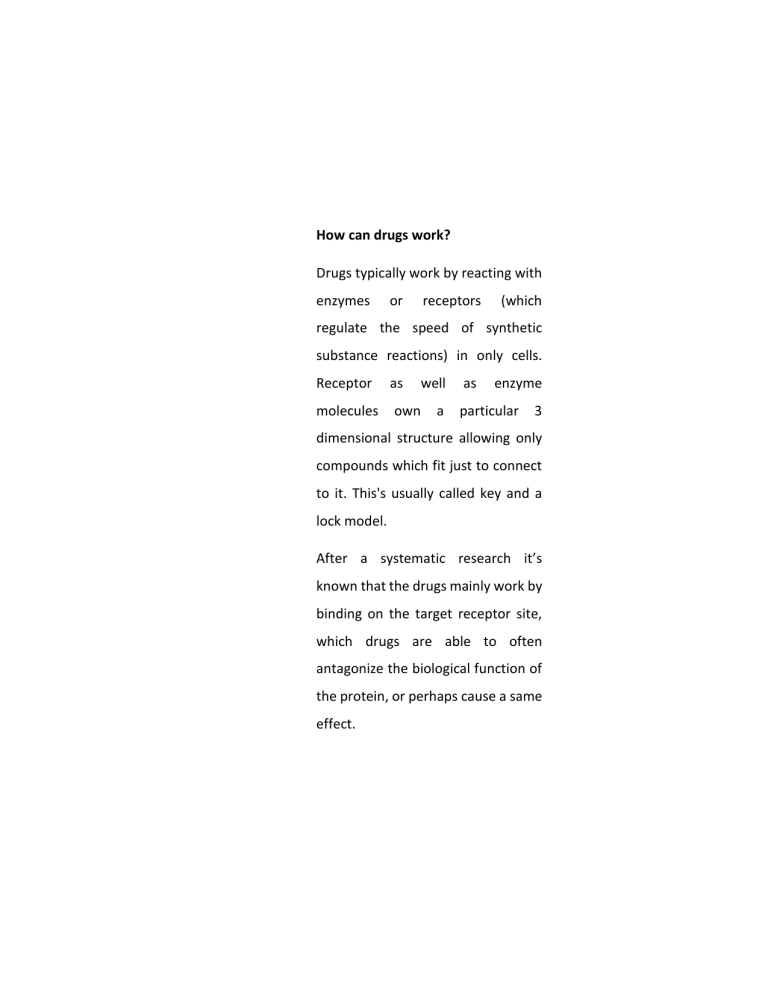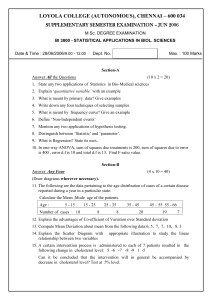
How can drugs work? Drugs typically work by reacting with enzymes or receptors (which regulate the speed of synthetic substance reactions) in only cells. Receptor as well molecules own a as enzyme particular 3 dimensional structure allowing only compounds which fit just to connect to it. This's usually called key and a lock model. After a systematic research it’s known that the drugs mainly work by binding on the target receptor site, which drugs are able to often antagonize the biological function of the protein, or perhaps cause a same effect. Medicines have a lot of diverse effects. Right here we're imagining of psychoactive medications which may be regarded as possibly blocking or activating receptors. Medicines normally have an impact on a number of different receptors and this's typically a great thing for recreational drug use in it softens the effect of alternative the medication. holds true The for medications in which pharmaceutical companies look for drugs with really precise consequences to be able to minimise unwanted side effects and also maximise the preferred medical use of the medication. Agonist is called for the drug when a drug make the protein receptor to react in the exact same technique as the naturally occurring compound. For examples of agonists are morphine, phenylephrine, nicotine, and then isoproterenol. Antagonists are drugs that react selectively with receptors but don't result in an observed effect. Instead they reduce the activity of an agonist at the receptor website involved. Receptor antagonists might be categorized as reversible or irreversible. Reversible antagonists easily disconnect from the receptor of theirs. We are able to measure how well the drug work by efficacy and potency: Efficacy The word efficacy is utilized in medicine and pharmacology to refer both to the highest effect attainable from a pharmaceutical medication in investigation options, and to the capability for sufficient therapeutic effect or maybe beneficial change in clinical settings. Potency potency is a degree of drug activity conveyed in regards to the quantity necessary to develop an impact of given intensity. A very potent drug (e.g., fentanyl, alprazolam, risperidone) evokes a certain result at low concentrations, while a drug of inferior potency (meperidine, diazepam, ziprasidone) evokes similar effect just at higher levels. Higher potency doesn't always mean much more side effects(1). Recent utilization on the residence time period idea Previous feedback have presented numerous examples of drugs for which very long residence period has translated into strong pharmacological exercise in vivo. That drug target residence period is able to influence in vivo pharmacodynamics has been mostly accepted, leading scientists to integrate this idea into versions of pharmacokinetic, pharmacodynamic interactions. Additionally, a few groups have used the residence time idea as a foundation for building ex vivo assays with what to calculate the extent as well as duration of target occupancy following dosing wearing preclinical pet models(3). HMG-COA reductase as example: Mechanism of action of HMG COA reductase inhibitors (statins) : Dose-Effect Correlation: You will see complicated techniques to detect the concentration dependent inhibition of HMG CoA reductase in human pharmacodynamic studies. The main medical variable is LDL cholesterol. The half life of LDL cholesterol is three to four days, which implies that a new stable state should be covered within two weeks of the beginning of statin therapy if the same artificial as well as catabolic prices apply during lipid reducing treatment. Nevertheless, in medical studies with statins a maximum stable state effect is noticed in four to six days. This's mirrored in worldwide recommendations dosage which adjustments of dosage shouldn't be viewed until after four weeks of treatment. Indeed, you will find a number of counter regulatory mechanisms which come into play and partially tend to counterbalance the simple relation to steady state half-life of LDL-cholesterol. The blockade of intracellular cholesterol biosynthesis (immediate consequence of any statin) or even a decreased cellular uptake of LDLcholesterol as a result of reduced plasma LDL ranges (later consequence of a statin) results in a transcriptionally controlled de novo synthesis of HMG CoA reductase. Hence, cholesterol biosynthesis improves and tends to reduce the expected number of LDL cholesterol reduction. Comparative Potency All marketed statins have mean reductions in LDL cholesterol similar to the twenty to thirty five % reductions proven to lessen big CHD events considerably in the larger intervention trials. pharmacodynamic A minor difference in between the statins will be the dosage during which a defined goal LDLcholesterol is reached. Mitchel have indirectly compared the consequences on LDL cholesterol of lovastatin, pravastatin and simvastatin in various clinical trials. Based on dose equivalence ratios, the realization was that simvastatin is two times as potent as pravastatin and lovastatin, that are just as powerful. Pooled information coming from controlled trials on fiuvastatin proved mean reductions in LDL cholesterol of 20.8 % (20 mg/day), 24.5 % (40 mg/day) as well as 32.5 % (80 mg/day). These reductions had been strongly like those reached with comparable doses of pravastatin(4 and lovastatin). References: 1. Piccinelli, M., Pini, S., Bellantuono, C., & Wilkinson, G. (1995). Efficacy of drug treatment in obsessive- compulsive disorder. Br J Psychiatry, 166, 424-443. 2. Copeland RA. Evaluation of enzyme inhibitors in drug discovery: a medicinal chemists pharmacologists. guide for and Wiley, Hoboken, NJ, USA; 2005 3. Walker I, Newell H. Do molecularly targeted agents in oncology have reduced attrition rates? Nat Rev Drug Discov 2009;8:15-6 4. Lennernäs, H., & Fager, G. (1997). Pharmacodynamics and pharmacokinetics of the HMG-CoA reductase inhibitors. Clinical pharmacokinetics, 32(5), 403-425.

